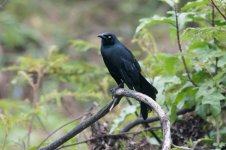Nutcracker
Stop Brexit!
Can anyone tell if this Wikipedia pic from Costa Rica (exact location unspecified, unfortunately) is a Nicaraguan Grackle (as claimed), or Great-tailed Grackle?
https://commons.wikimedia.org/wiki/File:Thirsty_(8387794451).jpg
My (very inexperienced) feeling is Great-tailed as (even despite the foreshortening) the bill looks very stout-based, suggesting a big, heavy bird. But I may well be wrong.
Is the bird's use of man-made infrastructure any clue?
Thanks!
https://commons.wikimedia.org/wiki/File:Thirsty_(8387794451).jpg
My (very inexperienced) feeling is Great-tailed as (even despite the foreshortening) the bill looks very stout-based, suggesting a big, heavy bird. But I may well be wrong.
Is the bird's use of man-made infrastructure any clue?
Thanks!






